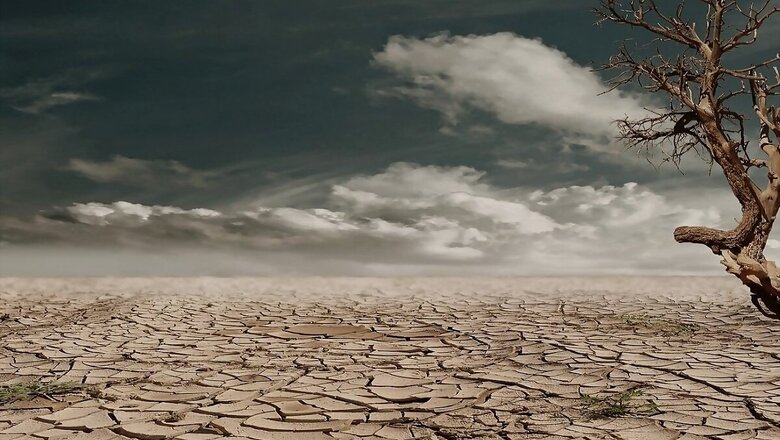
views
While global commons is facing a grave crisis due to repercussions of climate change, in recent years, the technology of weather modification through Carbon Dioxide Removal (CDR) and Solar Radiation Management (SRM) which China is employing, is bringing out new worries. Analysts believe that China may pursue this policy of climate modification to promote its geopolitical agenda, thus posing a challenge to global security. There is already a growing concern over China’s One Belt One Road (OBOR) project, which is causing massive environmental degradation through its construction activities in different parts of the world.
The genesis of China’s climate warfare strategy can be traced back to the enunciation of the policy — Regulations Governing Weather Modification — which was approved in May 2002. Under this policy, the Chinese government tacitly consented to use climate modification as part of an overall strategy of military warfare. Article 22 of the Regulations explicitly mentions that “the specific measures for the administration of weather modification activities carried out for military purposes shall be formulated by the Central Military Commission.” In this regard, it can be underlined here that since China’s weather modification technology has a military dimension, there is a need to look at its climate modification engineering techniques. Studies suggest Beijing may use this climate engineering technique to disrupt the neighbouring countries’ monsoons.
One may recall that it is not only China which is employing weather modification techniques for military purposes. The history of climate engineering goes back to the Cold War era when the United States deployed this technology in Vietnam and Laos in 1967. Under this programme of altering weather, the US Air force, as published in an article titled ‘Rainmaking Is Used As Weapon by U.S’ in 1973, written by Seymour M. Hersh, employed cloud seeding as a strategy, thus “hindering the movement of North Vietnamese troops and equipment and suppressing enemy anti-aircraft missile fire.” The other objective of the US strategy as highlighted in the article is “altering or tailoring the rain patterns over North Vietnam and Laos to aid the United States bombing missions.” However, the US climate war strategy in Vietnam was subjected to harsh criticism at that time from various quarters.
From the above case study of Vietnam, it is pretty clear that China’s strategy of climate warfare through bioengineering may hold true. In addition to the 2002 Resolution of China on weather modification, the Chinese Communist Party (CCP) brought out another Resolution titled ‘General Office of the State Council on Further Strengthening the Work of Weather Modification’ in 2012. The provision of the Resolution highlights to “accelerate the construction of command and communication systems, operational airspace declaration, approval systems, and improve operational command efficiency.” The study further highlights “mechanisms for close coordination among meteorological and military.” For augmenting the geoengineering program, China funded $3 million as reports suggest. Along with this, in 2020, the Chinese government issued a circular titled ‘China to forge ahead with weather modification service’ and stated that “by 2035, China’s weather modification should arrive at an advanced worldwide level in terms of operation, technologies, and services” as reproduced in China’s government website — The State Council of People’s Republic of China.
If one goes by the above policy measures initiated by China, it certainly generates an apprehension that Beijing is employing cloud engineering techniques as a military strategy. If this is true, it will significantly impact the geopolitics of global commons at large. Shiuh-Shen Chien, Dong-Li Hongb and Po-Hsiung Lin, in their study titled ‘Ideological and volume politics behind cloud water resource governance –Weather modification in China,’ published in Geo Forum in 2018 highlights the true intention of China in employing weather as a geopolitical strategy. The above article highlights that “China’s legislative and judicial institutions lack real power and civil society elsewhere are heavily repressed, allowing the authoritarian state to use whatever modern technology is at hand to tame the nature (and the environment) in the name of state interests. Thus, there is easy coexistence of the ideology of ecological modernization with authoritarian environmentalism practices” (p.226).
Studies further suggest that China had already demonstrated its capability of altering weather during the 2008 Olympics as well as in 2021 when it celebrated 100 years of the CCP. As news reports suggest, over the years, China has been deploying climate engineering in strategically significant Tibet (also known as the third pole) and Xinjiang. As reported in an article in South China Morning Post, titled ‘Chinese scientists use sound waves to increase rainfall on Tibetan Plateau,’ a group of researchers from Tsinghua University, through employing advanced research “recorded increases in rainfall of up to 17 percent by pointing a giant loudspeaker at the sky.”
Earlier in 2018, the Chinese government initiated another ‘sky-river rain-making project’ project to increase rainfall in Tibet. Under this project, as per an article by South China Morning Post titled ‘China needs more water. So it’s building a rain-making network three times the size of Spain’, more than 500 burners have been deployed on alpine slopes in Tibet, Xinjiang and other areas for experimental use. The news report further highlights that by employing these weather modification techniques, China hopes to secure around “10 billion cubic metres a year” which is around “7 percent of China’s total water consumption.”
It is a known fact that the Tibetan plateau is home to major rivers which is flowing to India, like Brahmaputra and Indus along with the Mekong river basin, which flows to South East Asia. By altering the weather condition in Tibet through deploying climate technologies, China is disturbing the climatic condition, affecting the rainfall. It has been observed that Tibet glaciers are melting fast, which is also responsible for erratic climate behaviour. A study done by the Swiss Federal Institute for Forest, Snow and Landscape Research, and published in Phys.org titled ‘Why are the glaciers in southeast Tibet melting so fast?’ shows that glaciers are melting at a faster rate “due to less summer snowfall.” Along with this, the temperature of Tibet is increasing very fast around “0.3 to 0.4 C…twice the global average” as per a study by Jane Qiu titled ‘Trouble in Tibet,’ published in the Journal Nature in 2018. Climate engineering initiated by China and climate change through shrinking glaciers may impact water flow to India and South East Asian countries. Major rivers like the Mekong, which flows to Southeast Asian countries, and the Brahmaputra and Indus, which flow to India will be affected by this. This may precipitate irregular floods, impacting human lives and property and causing resource scarcity like aridity. Similarly, irregular water flow due to a rise in temperature along with the melting of glaciers may also cause drought-like situations and affect food production. China, being an upstream country, is in a better position to control water flow to India and South East Asia.
Kazakhstan is also facing threats from Ili and Irtysh rivers which originate in Xinjiang and flow to Kazakhstan. The irregular rainfall in Xinjiang is attributed to the flood in Kazakhstan. In this regard, as studies suggest, it is necessary to mention that Kazakhstan has been suffering immense environmental degradation due to climatic disturbances in Xinjiang.
The weather engineering technique, which China is employing both in Tibet and Xinjiang, may have a repercussion on the environmental security of neighbouring countries. Looking at the nature of secrecy associated with China’s research, one can imagine that in the long run, China’s climate engineering initiatives will pose a serious threat to global commons, particularly to South Asia, Southeast Asia and Central Asia.
In the context of global geopolitics, it has been observed by scholarly studies that climate change is going to have an adverse effect on security at a broader level. The Intergovernmental Panel on Climate Change (IPCC) also raised the same concern in its various reports. One has to look at China’s policy of weather modification engineering and its impact on global and regional security. China is suffering the most at the domestic level due to climate-related vulnerability. In this context, the 2022 IPCC report titled ‘IPCC Sixth Assessment Report: Impacts, Adaptation and Vulnerability’ has also outlined the potentially harmful impact of climate on China, including declining food production, aridity, and growing flash floods. In this context, climate engineering will provide short-term advantages for China but might prove to be more hazardous in the long run. As discussed above, it is very difficult to segregate China’s civilian and military operational spheres; both work under the Chinese military.
In this regard, it is pertinent to highlight ‘resources warfare’ and ‘ecological warfare’ as part of the hybrid warfare strategy outlined by Qiao Liang and Wang Xiangsui in their book Unrestricted Warfare, published in 1999. The guiding principle of China’s warfare strategy is drawn from Sun Zi’s strategic dictum that “the other army is subdued without fighting” by employing a non-military warfare strategy as quoted in the above book. China uses climate engineering as part of its military doctrine employing ‘ecological warfare’ as a tool for its war efforts. Some of the instances, like China’s construction of artificial dams in the South China Sea and militarizing them, along with the construction of dams in Tibet, as discussed above, and employing climate modification techniques which will affect neighbouring countries are all part of the strategy of ecological warfare. As reported in the South China Morning Post in a 2018 article ‘Could this new Chinese radar system be used to play God with the weather?’, the People’s Liberation Army has funded many research works on ionosphere weapons. “They included an airborne device to release a large number of chemicals in the high atmosphere to create a communication ‘black hole’ over enemy forces.” This, as the above article highlights, will serve China’s ‘strategic needs’ and pursue ‘frontier issues’ in space.
The climate engineering technology which China is employing to alter the weather is going to have a repercussion on the geopolitics of the neighbouring countries of South and Southeast Asia and Central Asia. Though China is a signatory to the ‘Convention on the Prohibition of Military or Any Other Hostile Use of Environmental Modification Techniques (ENMOD)’ signed in 1978, which under Article 1 underlines, “States parties undertake not to engage in military or any other hostile use of environmental modification techniques having widespread, long-lasting or severe effects as the means of destruction, damage or injury to another State party.” However, looking at China’s non-compliance with many international agreements, it can be stated that Beijing pays scant attention to the obligations mentioned in the Agreement.
In this regard, it can be stated that China is more interested in using climate engineering as a geopolitical weapon to threaten its neighbouring countries. The threat by China is more pronounced when the centralised CCP provides an ideological and strategic justification for such acts. The country is already under scrutiny for causing massive environmental degradation through OBOR. There is a need to put China’s climate engineering technologies under international scrutiny.
The author teaches at School of International Studies, JNU, New Delhi. Views expressed are personal.
Read all the Latest Opinions here
















Comments
0 comment